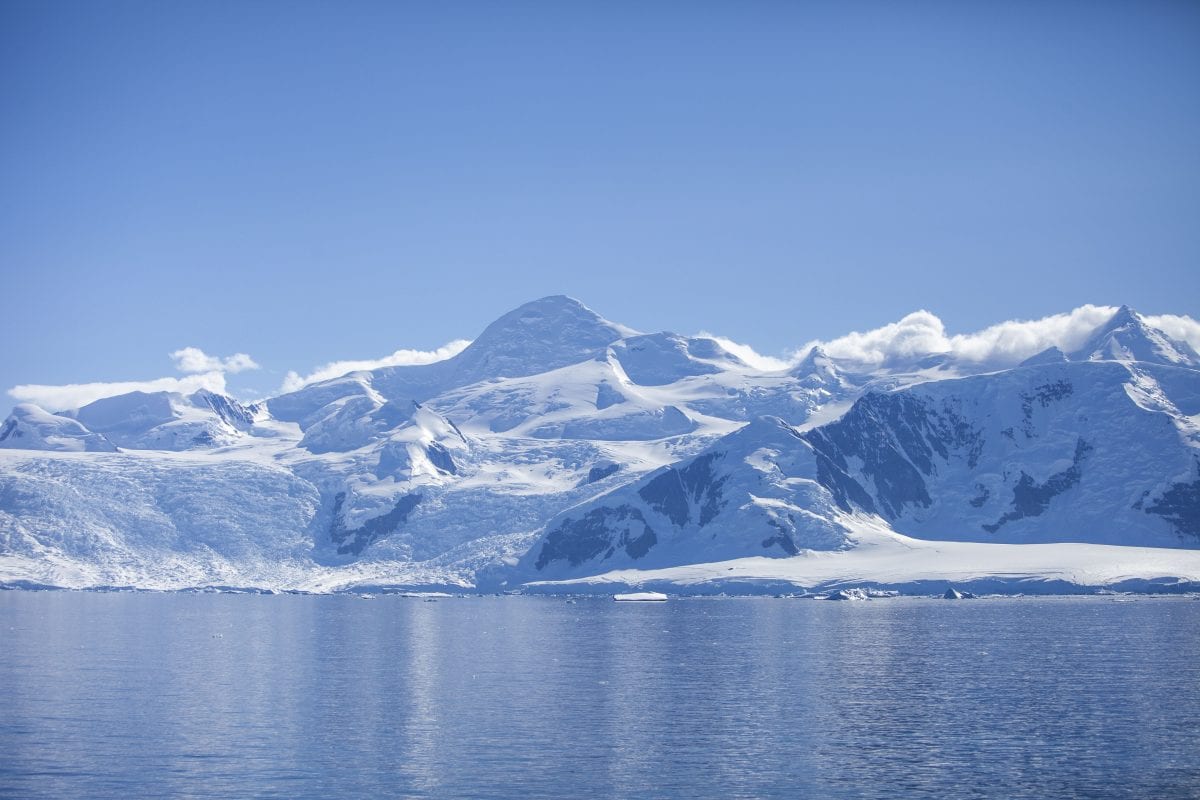Antarctic Ice Sheet Loss Expected to Affect Future Climate Change
 Antarctica seen from the R/V Laurence M. Gould. Photo by Dan Lowenstein, © Woods Hole Oceanographic Institution
Antarctica seen from the R/V Laurence M. Gould. Photo by Dan Lowenstein, © Woods Hole Oceanographic Institution September 25, 2020
Research simulates dramatic climate impacts for future Antarctic ice sheet melt
In a new climate modeling study that looked at the impacts of accelerated ice melt from the Antarctic Ice Sheet (AIS) on future climate, a team of climate scientists led by Alan Condron at Woods Hole Oceanographic Institution (WHOI), reports that future ice-sheet melt is expected to have significant effects on global climate.
The research team, which also included Shaina Sadai and Rob DeConto at the University of Massachusetts Amherst, and David Pollard at Pennsylvania State University, presented their findings this week in Science Advances. The study predicts how future climate conditions could change under high and low greenhouse gas emissions scenarios, while accounting for accelerated melting of the AIS.
Scientists have long recognized that future meltwater input from the Antarctic will affect the Southern Ocean and global climate, but ice-sheet processes are not currently included in even the most state-of-the-art climate prediction simulations. The research team reports that their new models with the added ice melt information reveal important interacting processes and demonstrate a need to accurately account for meltwater input from ice sheets in order to make confident climate predictions.
“In the ice sheet models run by my co-authors Rob DeConto and David Pollard, large parts of the West Antarctic ice sheet (WAIS) rapidly collapse about 100 years from now,” says Condron. “Simply put, previous climate models have not addressed how all that fresh water coming out of the AIS might impact future climate.”
“We found that future meltwater coming off Antarctica leads to huge amounts of thick sea ice around the continent,” adds Sadai, lead author of the study and PhD graduate student of Condron. “With higher greenhouse gas emissions, the ice sheet melts faster, which in turn leads to more freshwater flowing into the ocean and more sea ice production.”
All this additional sea ice dramatically slows the pace of future warming around Antarctica, the researchers report, which is seemingly welcome news. The climate impacts are not just restricted to the Antarctic, Condron points out that the cooling effects of this melt water are felt worldwide.
“It’s important to note that this is not a global ‘cooling’ scenario as average global temperatures would still be roughly three degrees Celsius warmer than today due to human greenhouse gas emissions, even with the cooling effects of this melt water on climate,” says Condron.
But that is not the end of the story. “Even though the atmospheric warming slows, in the deeper part of the ocean where the base of the WAIS is touching the ocean floor, we see water temperatures warming up to one degree Celsius. This subsurface warming could make the ice sheet much more unstable and accelerate rates of sea level rise beyond current projections,” Condron says.
While the delayed future warming found in the new simulations may sound like good news, the researchers say it is important to keep in mind that serious warming and sea level rise will still occur with unabated greenhouse gas emissions, which will impact coastal communities and ecosystems worldwide.
This research was supported by the National Science Foundation (NSF) Office of Polar Programs through NSF grant 1443347, the Biological and Environmental Research (BER) division of the U.S. Department of Energy through grant DE-SC0019263.
The Woods Hole Oceanographic Institution (WHOI) is a private, non-profit organization on Cape Cod, Massachusetts, dedicated to marine research, engineering, and higher education. Established in 1930, its primary mission is to understand the ocean and its interaction with the Earth as a whole, and to communicate an understanding of the ocean’s role in the changing global environment. WHOI’s pioneering discoveries stem from an ideal combination of science and engineering—one that has made it one of the most trusted and technically advanced leaders in basic and applied ocean research and exploration anywhere. WHOI is known for its multidisciplinary approach, superior ship operations, and unparalleled deep-sea robotics capabilities. We play a leading role in ocean observation, and operate the most extensive suite of data-gathering platforms in the world. Top scientists, engineers, and students collaborate on more than 800 concurrent projects worldwide—both above and below the waves—pushing the boundaries of knowledge and possibility. For more information, please visit www.whoi.edu
Key Takeaways
- Even the most state-of-the art climate models currently do not account for changes in the melting of the Antarctic Ice Sheet (AIS) caused by climate change. In particular, they do not consider the vulnerability of the West Antarctic Ice Sheet (WAIS) to rapid retreat and collapse.
- Using a sophisticated new ice sheet and climate model, the study found that a future collapse of the WAIS could dramatically cool the Southern Hemisphere by up to 10 degrees Celsius. Significantly, this cooling reduces the projected rise in global temperature by up to two degrees Celsius.
- The global temperature reduction should not be regarded as a 'global cooling' scenario though. Average global temperatures would still be around three degrees Celsius warmer than today about a century from now, but this is cooler than the roughly five degrees Celsius warming currently projected under high greenhouse gas emission scenarios.
- The opposite temperature response is found in the ocean at the base of the ice sheet where the ice is 'glued' to the bedrock. Here, water temperatures could warm by one to two degrees Celsius, which could reduce the future stability of the AIS and accelerate rates of ice loss and projected rates of sea-level rise beyond current projections.
